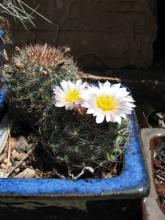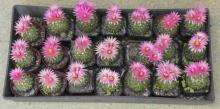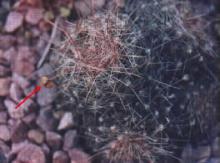Desert alpines: yeah sure. I guess there are some truly deserty ranges in the Great Basin where cacti are alpines. The White Mountains come to mind, where I recall Opuntia trichophora growing among the Bristlecones. Our poor mountain ball cactus, (Pediocactus: "Plains cactus" is the literal translation: get real, the munchkin ALWAYS grows on mountains), first impugned by its very Latin name, and then supposed to grow in deserts when in fact millions upon millions of these crowd the foothills and montane meadows of the Southern Rockies ONLY in relatively mesic, acid soil regions. I dote on this: and I confess it grows pretty well in my unwatered dryland gardens. But it also does well with some irrigation. I especially like to grow them in pots where they can sit for years (best to repot after five years or so I've found). They produce an amazing array of colors from deep rose reds and near purple to these shimmering Chinese jade shades like this form of "Robustior" from the Pacific Northwest I got from Mesa Gardens: not like the deep purple forms I otherwise know...it could be blooming in a month!
Comments
Re: Dontcha love oxymorons?
Aw, Todd, I don't think you should be called an oxymoron just for growing cacti in Newfoundland! There's no call for that!
I had always pointedly ignored cacti and most succulents because I seemed to be involved with too much stuff already and I had to draw the line somewhere. No cacti, no roses, no annuals, no monocarps. But your photo intrigued me and I Googled Pediocactus, and High Country Gardens had it, with further offerings labeled something like "if you like this, you'll love..." Echinocereus. I started thinking about some of the dwarfest, hardiest varieties in desert landscapes in my shallow troughs. Mmmmmm...
Can you recommend a book to get me started in learning about this group? J
Book on succulents..
It may sound a bit funny, but really the book designed for you is "Hardy Succulents" by Gwen Moore Kelaidis, who happens to be my ex-wife. I think I can honestly say she did a better job writing this book than almost anyone else I can imagine, primarily because she didn't used to be a succulent afficionado: except for sempervivums and sedums, I hasten to add (she's always liked those). But hardy ice plant, cacti, yuccas and agaves were actually things she rather resented my insisting we include in the garden. Part of the reason I grew so many cacti in pots and troughs was because she didn't want them in the ground (she might prick her fingers you see). Over time, I saw how these plants captivated her and in her new garden she actually has quite a few cacti planted in HER PERENNIAL BORDER (how crazy is that?). In her defense, I also should admit that most of the pots and troughs I planted to cacti were of her manufacture. Gwen's book is graced with really stunning photography by Saxon Holt, one of the all time great photographers...and her writing is very beguiling and on the mark (a hallmark of her style in general). And the book is ridiculously cheap on Amazon. Bet you don't see glowing reviews like this by many exes...btw, if you are new to cacti, Echinocereus reichenbachii, Escobaria vivipara and E. sneedii var. leei are pretty much indestructible everywhere (given drainage and sun).
Re: Dontcha love oxymorons?
... and, of course, Opuntia polyacantha and O. fragilis can be added to that list (as the absolute hardiest North American species). Those two, plus Escobaria vivipara (formerly Coryphantha vivipara, and also Mamillaria vivipara) occur across the prairie grasslands up in this neck of the woods, to rather northerly latitudes.
Re: Dontcha love oxymorons?
It seems Escobaria has been absorbed back into Coryphantha, according to the Flora of North America. Escobaria still is held among cactus aficionados. I see Laura Serowicz(sp?) Chose Coryphantha vivipara when I sent my seed in as Escobaria.
I have never had a cactus seed germinate so easily as C. vivipara. It needs no pretreatment, and germinates well at room temperature.
Re: Dontcha love oxymorons?
It seems Escobaria has been absorbed back into Coryphantha, according to the Flora of North America. Escobaria still is held among cactus aficionados. I see Laura Serowicz(sp?) Chose Coryphantha vivipara when I sent my seed in as Escobaria.
I have never had a cactus seed germinate so easily as C. vivipara. It needs no pretreatment, and germinates well at room temperature.
An awesome pan of muffins there Rick! I like the pink frosting ;D
Re: Dontcha love oxymorons?
And along the line of our avatars, Mark: I kid you not. This really happened!
My cactus "ate" an Asian lady beetle.
And a small advertisement.
Re: Dontcha love oxymorons?
And along the line of our avatars, Mark: I kid you not. This really happened!
My cactus "ate" an Asian lady beetle.And a small advertisement.
;D ;D ;D
Re: Dontcha love oxymorons?
It may sound a bit funny, but really the book designed for you is "Hardy Succulents" by Gwen Moore Kelaidis, who happens to be my ex-wife. ...btw, if you are new to cacti, Echinocereus reichenbachii, Escobaria vivipara and E. sneedii var. leei are pretty much indestructible everywhere (given drainage and sun).
PK, thanks for the advice. The book is ordered. And I'm so new to cacti that I don't have any yet! I tend to like the look of the barrel-shaped ones over the pad-shaped ones, but perhaps I just need to be educated. Good to read that some are easy from seed, as I had heard that Pediocacti aren't. I hope to use them in mixed troughs eventually. Not in the perennial border, though!
Re: Book on succulents..
Part of the reason I grew so many cacti in pots and troughs was because she didn't want them in the ground (she might prick her fingers you see).
One of my own garden rules, is don't plant anything with thorns... I hate getting pricked by thorns. I suppose one day when I do try hardy cactus (I want to badly), I'll have to figure out failsafe methods of weeding and blown-in leaf removal. :)
Re: Dontcha love oxymorons?
AAaaaahhh, Marko: you are revealing that you do not work in public horticulture: we who do LOVE thorns: we love plants that devour, that stab, that defend themselves. We love those especially that might prove fatal, especially to obnoxious kids who trample tender plants underfoot. We yearn for a Nettle/Amorphophallus/Dionaea cross that will be big and strong enough to swallow up and digest parents who don't discipline their children in public places. We adore agaves with long, long spines that might impale visitors who touch things they shouldn't and steal seed (or plants) without permission. We adore thistles: the nastier the better. Ones that are mounds of soild, long prickly and painful spines. Very painful. Possibly LETHAL! Brwaaaa haaaa HAA!
Re: Dontcha love oxymorons?
I draw the lined with those whose thorns release and embed in your skin. None of them for me.
Jeremy (or anyone) I still have loads of Coryphantha vivipara seed, even after I donated to the NARGS Seed Ex. Provenance is South Dakota, near the Minnesota boarder. They are probably the most water and humidity tolerant of any variation of the species, and so best suited for your climate. I've discovered they are pretty much self infertile. Insects here do visit the flowers, but they don't seem to be very good pollinators. Since I started hand pollinating, the berry crop is very generous. They look scrumptious, and it seems somewhere sometime I read that Indians ate them. But I need some solid evidence regarding their edibility before I start popping them in my mouth for a snack. If anyone has a reference in respect to its edibility, I'd appreciate a heads up.
So if anyone would like some seed, send me your address.
Re: Dontcha love oxymorons?
AAaaaahhh, Marko: you are revealing that you do not work in public horticulture: we who do LOVE thorns: we love plants that devour, that stab, that defend themselves. We love those especially that might prove fatal, especially to obnoxious kids who trample tender plants underfoot. We yearn for a Nettle/Amorphophallus/Dionaea cross that will be big and strong enough to swallow up and digest parents who don't discipline their children in public places. We adore agaves with long, long spines that might impale visitors who touch things they shouldn't and steal seed (or plants) without permission. We adore thistles: the nastier the better. Ones that are mounds of soild, long prickly and painful spines. Very painful. Possibly LETHAL! Brwaaaa haaaa HAA!
Aciphylla plantations, Panayoti? ;) ;) ;)
Re: Dontcha love oxymorons?
AAaaaahhh, Marko: you are revealing that you do not work in public horticulture: we who do LOVE thorns: we love plants that devour, that stab, that defend themselves. We love those especially that might prove fatal, especially to obnoxious kids who trample tender plants underfoot. We yearn for a Nettle/Amorphophallus/Dionaea cross that will be big and strong enough to swallow up and digest parents who don't discipline their children in public places. We adore agaves with long, long spines that might impale visitors who touch things they shouldn't and steal seed (or plants) without permission. We adore thistles: the nastier the better. Ones that are mounds of soild, long prickly and painful spines. Very painful. Possibly LETHAL! Brwaaaa haaaa HAA!
Panayoti, I can well imagine that Nettle/Amorphophallus/Dionaea cross ;D, although you might want to blend in some Drosera, so those who venture too close to your monstrous hybrid will actually stick to the plant and suffer slow death by amorphophallic asphyxiation.
I'm not very well travelled, but I did spend a summer in Tunisia one year during my college days. It is common practice there to make impenetrable wall-fences by mounding clay soil very high and steep and planting the whole affair with Opuntia, the opuntias luxuriating and fruitful when grown this way.
I'm thinking of going the stinging nettle route myself, but upping the ante in an alpine inspired theme, my property surrounded with walls of steeply mounded soil densely planted with Chilean Caiophora and Loasa.
http://www.chileflora.com/Florachilena/FloraEnglish/HighResPages/EH0052.htm
Re: Dontcha love oxymorons?
They've change the format and added some stuff since I last visited that Chilean site. I like it.
Re: Dontcha love oxymorons?
I draw the lined with those whose thorns release and embed in your skin. None of them for me.
Jeremy (or anyone) I still have loads of Coryphantha vivipara seed,
So if anyone would like some seed, send me your address.
Rick, thanks for the offer, I'd love to give them a try. I'll send my address privately.
Re: Dontcha love oxymorons?
First of all, Booker: yes indeed! I would LOVE to have plantations of Aciphyllas. But although I've grown quite a few Raoulia, Hebe spp, and various other New Zealanders, I have yet to overwinter an Aciphylla. I grow them superbly through the summer, but apparently, our steppe winter is too much for them. Phooey, I say! I had visions of planting these little bronze yucca lookalikes near their silvery North American cousins! If you know of any Aciphyllas that might grow in our god forsaken windy, frigid alternating with roasting climate, let me know!
And as for Loasaceae, Mark, I have grown a number over the years. Blumenbachia hieronymi thrived in the Rock Garden for several decades, although I suddenly realized we no longer have it. It was not dazzling, but the flowers were quite beautiful up close, and the seed pods were intricate, complicated and interesting. It bloomed for several months during the heat of the summer: a good thing in a plant! I must get it back! I remember seeing the giant white lantern Caiophora (coronata I think it's called) above treeline in the Andes: magnificent! And a screaming orange Loasa lateritia (I'm pretty sure that was the name) on a very steep scree above Laguna del Maule, which ranks with Sani Pass, Sentinel, Burhat Pass, Mt. Parnassos, the Tien Shan above Almaty, Maloja Pass, Hoosier Pass, Mt. Eddy, Carson Pass and the Beartooth as some of my "peak" wildflower days. Walking ankle for miles deep through rosulate violas is not easily topped. Oops: I forgot Railroad Ridge and oh yes, our hike up Grandfather Mountain wasn't half bad!
Re: Dontcha love oxymorons?
Rick, the Coryphantha seed arrived today. So many, very generous of you! I'm sterilizing the planting mix now (sand had been outside and who knows what it might have picked up). I'm trying it with a little crushed Dolomitic limestone added as an experiment, but only with 24 seeds, there'll be plenty more if they don't thrive. Thanks! J
Re: Dontcha love oxymorons?
Sterilization or pasteurization should not be necessary. I usually start with a potting mix (pasteurized, but sometimes the bag is opened for more than a year) but add plain ol' sand from a variety of sources raw. Never had any disease problems with Coryphantha.
I never got any good pics of the little green maggots standing on end (you'll know what I mean when they sprout). I'm sure we'd all like to see them. Maybe start a new Genus thread or Propagation thread and post some photos with commentary...
Re: Dontcha love oxymorons?
Well, I just ordered a cheap webcam. I can set it up and beam riveting live little green maggot growth footage on the Forum! Do we have that capability? More fun than watching paint dry!
But seriously, I'll try to document the process. Sure, no pressure. They just have to turn out like your perfect rack of pink frosting-topped little green barrels! Oi!
Re: Dontcha love oxymorons?
Will Coryphantha vivipara take frosts? As near as I can tell we are in the equivalent of your zone 10. Hot, dry, make that very dry summers, sandy soils, and reasonably heavy frosts with accasional light snow falls. I have the ideal sit with natural rocky outcrops of sandstone. ???
Re: Dontcha love oxymorons?
Will Coryphantha vivipara take frosts?
Coryphantha vivipara is native up through the Canadian prairies, where lows of -40 deg F (and worse) occur regularly*.
http://plants.usda.gov/java/profile?symbol=ESVI2
Frost is not a problem. :)
(*I imagine some of the subspecies that are adapted to warmer areas may be slightly less hardy.)
Re: Dontcha love oxymorons?
The issues in fact might be the opposite for someone in hot zone 10--some of the cold adapted species don't like year round warm temperatures (haven't head re: vivipara, but I know of people struggling with Opuntia fragilis in warm places, and Pediocactus is said to not like warm summer nights); You can always try, but why bother? there are so many wonderful cacti that will thrive in zone 10!! I trying vivipara, I'd first go for the southern forms which at least will be more accustomed to hot summers...
Re: Dontcha love oxymorons?
Oh, it's good fun discovering what goes on in these threads. Back to Panayoti and his designs on designing a triffid. My idea of planting Yucca whipplei was to attract visitors - so far it has only impaled me! The only cactus I have grown is that amazing Maihuania (have I got that right?) which flowered beautifully on a raised bed of deep grit. One of the oldest members of our Group, who lives as far south-east as you can go at Broadstairs, had Y. whipplei flower some years ago. It must have been 15ft high and towered up above the veranda on the second storey of the house! We are opposite the exit of the M2 Motorway so when ours flowers I expect traffic chaos across the road!





We are growing Pediocactus simpsonii in our alpine house...only in Newfoundland!...talk about oxymorons!